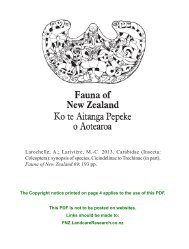PDF File - Landcare Research
PDF File - Landcare Research
PDF File - Landcare Research
Create successful ePaper yourself
Turn your PDF publications into a flip-book with our unique Google optimized e-Paper software.
New Weed Identification Key Online<br />
A new interactive key has been developed that will be a big<br />
help for people who need to identify weeds in New Zealand.<br />
The computer-based online key draws on the National Pest<br />
Plant Accord (NPPA) Key, which was completed in July<br />
2009 (see Plant Identifi cation Keys Now Online, Issue 49),<br />
and the Department of Conservation’s consolidated list of<br />
environmental weeds in New Zealand. “The new key covers<br />
more than 500 plant taxa (species, subspecies, varieties,<br />
hybrids and cultivars), including about 150 NPPA species,<br />
330 environmental weeds, and many similar species and<br />
close relatives,” said Murray Dawson, the lead developer.<br />
The key is available for use, free of charge, on the <strong>Landcare</strong><br />
<strong>Research</strong> website (see www.landcareresearch.co.nz/research/<br />
biosystematics/plants/weedskey/index.asp or use the<br />
shortcut http://tinyurl.com/weedkey).<br />
As with the original NPPA Key, which it replaces, the<br />
New Zealand Weeds Key was very much a team effort.<br />
Murray and Peter Heenan (of <strong>Landcare</strong> <strong>Research</strong>) worked<br />
with Trevor James (Ag<strong>Research</strong>), who provided the majority<br />
of images, Sheldon Navie (University of Queensland), who<br />
provided data from similar keys he has developed in Australia,<br />
and Paul Champion (NIWA), who provided expertise on<br />
aquatic species. All fi ve authors provided images for the key<br />
and further illustrations were contributed by the Department<br />
of Conservation, Weedbusters, regional authorities, and<br />
overseas contributors. The key is well illustrated with about<br />
9,000 images showing a range of features for each plant<br />
– e.g. plant form, leaf, fl oral, fruit and seed characteristics.<br />
Only 11 taxa lack images and these will be added when they<br />
become available.<br />
The key works by selecting any of 48 characters and the<br />
216 character states scored for each taxon. “For old man’s<br />
beard (Clematis vitalba), for example, the character state<br />
for Plant Form is Vine and the character state for Leaf<br />
Arrangement is Opposite,” said Murray, “It’s really easy to<br />
use.” The plant names follow the <strong>Landcare</strong> <strong>Research</strong> Ngā<br />
Tipu o Aotearoa – New Zealand Plants databases. There are<br />
several cases where the taxonomic names used in the new<br />
key are more recent than those listed in the NPPA manual<br />
and the Department of Conservation list of environmental<br />
weeds – both published in 2008. These name changes are<br />
recorded within the key (as synonyms in brackets) and in<br />
comparison tables (at www.landcareresearch.co.nz/research/<br />
biosystematics/plants/weedskey/species.asp).<br />
The key includes links at the species level to related websites<br />
such as MAF Biosecurity New Zealand, the New Zealand<br />
Plants databases, and Weedbusters New Zealand, all of<br />
which provide further information on the plants. A new<br />
feature also allows the user to retrieve lists of NPPA species<br />
and environmental weeds, the suffi xes “NPPA” and “EW”,<br />
respectively, having been added to the names of these plants<br />
within the key.<br />
The new interactive key to the weed species of New Zealand<br />
is a unique and extensive resource. It is a powerful tool that<br />
makes it easy to identify weedy plants without having to learn<br />
complex botanical terminology.<br />
Further online interactive keys are being developed at<br />
<strong>Landcare</strong> <strong>Research</strong> – these will also be free to use and are<br />
two-year projects. Murray Dawson, Jeremy Rolfe, and the<br />
New Zealand Native Orchid Group have started work on a<br />
key to the New Zealand native orchids – a group of diffi cultto-identify<br />
plants with high conservation values. Also, a team<br />
led by David Glenny has started working on a key to fl owering<br />
plant genera in New Zealand, covering both native and<br />
naturalised plants; sounds like a big job!<br />
The development of this key was funded by the Terrestrial<br />
& Freshwater Biodiversity Information System (TFBIS)<br />
Programme and is based on LucidTM software (developed by<br />
the CBIT in Australia). The TFBIS Programme is funded by the<br />
Government to help achieve the goals of the New Zealand<br />
Biodiversity Strategy, and is administered by the Department<br />
of Conservation.<br />
CONTACT: Murray Dawson<br />
(dawsonm@landcareresearch.co.nz)<br />
Keying out gorse using the new Weeds Key.<br />
11
















